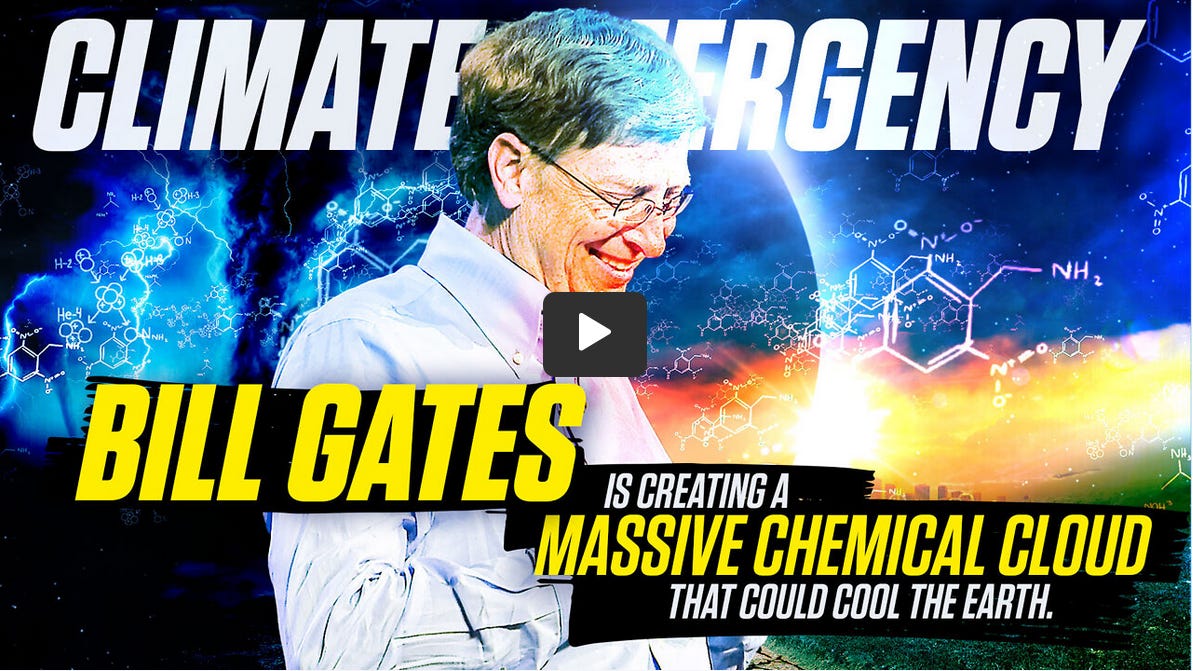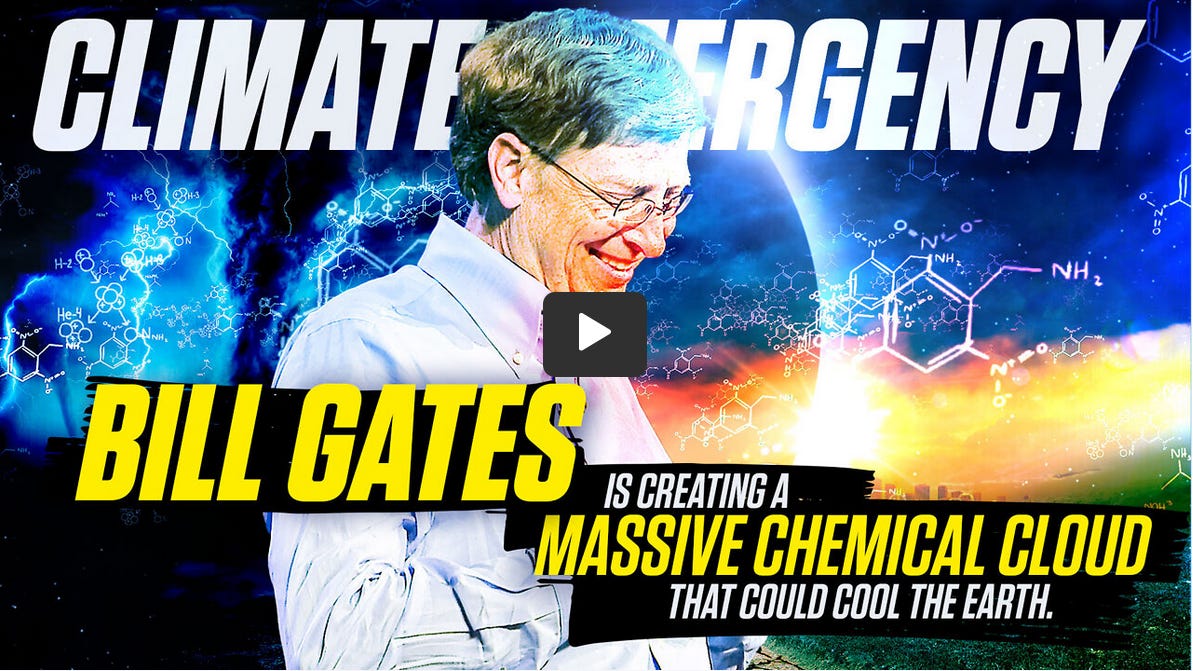Operation Popeye: How the US Government Turned the Weather Into a Weapon of War…
Operation Popeye relied on a technique called “cloud seeding,” where crystals are dropped into clouds to induce rainfall.
One-time or recurring donations can be made through Ko-Fi:
By Revolver News August August 28, 2023
During the Vietnam War, the U.S. was up against the ropes. Anti-war protests were growing louder, and our military was taking heavy losses. It was crunch time, and that’s when the U.S. government rolled out one of their wildest cards: “Operation Popeye.” What was it? A secret plan to turn the weather into a weapon to make it rain and flood out the Ho Chi Minh Trail — the Viet Cong’s main thoroughfare.
Though it cycled through several names in its history, “Operation Popeye” stuck. Its stated objective—to ensure Americans won the Vietnam War—was never realized, but the revelation that the U.S. government played God with weather-altering warfare changed history. The Nixon administration distracted, denied, and, it seems, outright lied to Congress, but enterprising reporters published damning stories about rain being used as a weapon, and the Pentagon papers dripped classified details like artificial rain. Eventually, the federal government would declassify its Popeye documents and international laws aimed at preventing similar projects would be on the books.
But the public would, more or less, forget it ever happened. Given the rise of geo-engineering projects, both from municipal governments and private companies, some experts believe Popeye is newly relevant.
Operation Popeye relied on a technique called “cloud seeding,” where crystals are dropped into clouds to induce rainfall.
The Popular Science article continues:
At first, no one seemed to consider the wartime applications of cloud seeding, but on March 20, 1967, the “operational phase” of Popeye began. Pilots and their crew would soar over select regions of Vietnam with a canister of silver or lead iodide, which were, by the 1960s, considered two of the primary sources of water condensation nuclei. The plane crew would ignite the canisters and release particle-rich smoke into an existing storm. If all went well, the jolt of artificial nuclei would reverberate through the system, forcibly spurring additional precipitation.
Despite 80 years of cloud seeding efforts, rigorous research aimed at proving (or disproving) its efficacy is still underway. During their top secret briefing on Popeye, Senators Pell and Case were told that though U.S. taxpayers paid, without their knowledge, some $3.6 million a year for such operations over Vietnam (or about $23 million a year in today’s dollars), Popeye’s success was “certainly limited” and also fundamentally “unverifiable.”
As he digested these facts—processed the full extent of the secret wartime weather manipulation project—Senator Pell seemed increasingly indignant, as documented in the official meeting report. Why, he asked, was it kept secret? And what other secrets were there? “The thing that concerns me,” Pell said, “is not rainmaking per se, but when you open Pandora’s box, what comes out with it?” When the details of Operation Popeye were made public a two months later, on May 19, 1974, many Americans—as well as our allies and enemies abroad—were left pondering the same question.
Here’s an even deeper dive into Operation Popeye:
When news about Operation Popeye broke, public outrage came fast and furious. Leaders responded by quickly throwing together a treaty that supposedly banned the use of weather as a weapon. However, much like other instances where the U.S. government self-regulates, this move was symbolic and lacked teeth. The Popular Science article continues:
Environmental Modification Convention, the international treaty bars any action undertaken by military or otherwise hostile forces that could result in “earthquakes, tsunamis; an upset in the ecological balance of a region; changes in weather patterns (clouds, precipitation, cyclones of various types and tornadic storms); changes in climate patterns; changes in ocean currents; changes in the state of the ozone layer; and changes in the state of the ionosphere.” The convention is, in effect, so comprehensive it bans many forms of weather modification that, at least according to publicly-available knowledge, do not yet exist. While there’s an elaborate 12-step WikiHow for a tornado in a bottle, storms don’t appear to be that easy to create—or, for that matter, stop—in the real world. Cloud seeding, if and when it works, is successful only because it piggybacks on existing weather, rather than creating new storm fronts from scratch.
But Deborah Gordon, director of the energy and climate program at the Carnegie Endowment for International Peace, says the convention is ultimately toothless. “You don’t even know where to look,” she says of current weather manipulation efforts. “There’s a lack of transparency in the research. We don’t even know what people are working on. You can’t govern something you can’t see. And that’s for peaceful applications.” Without the ability to measure these modifications, the Environmental Modification Convention or any other weather-related treaty is nearly impossible to enforce. “How will we know that there aren’t Operation Popeyes… going on or not?” she asks.
Given our inability to monitor these activities, there’s reason to be concerned that the United States or other nations could quietly violate the terms of the convention. But, Gordon says, the more pressing question is whether thousands of small-scale environmental modification projects already underway will eventually add up to global impact. “It didn’t matter [that there was no transparency], because there were so few projects,” Gordon says of the 20th century. But “in the last decade,” she says, “the uptick in experimentation in terms of climate engineering has not only picked up from the government’s point of view… it’s now picked up in the private space.”
[…]
In recent years, Gordon says, we’ve also seen the move beyond privately-led weather-altering schemes to climate-altering ones. Big corporations like Shell, as well as dozens of smaller startups like Carbon Engineering, have developed and begun to implement carbon capture technology. While these peacetime projects are all intended only to benefit the local community, they’ve become so widespread they could have an affect at a planetary scale. “If there’s enough local weather modification,” she asks, “at what point does that add up to more than the sum of its parts?”
Do we really trust globalist governments, who are relentlessly promoting their climate change agendas, to hold the power to control the weather? Can we be confident they won’t engineer extreme weather disasters just to validate their doomsday climate predictions?
Additionally, can we really trust our leaders not to introduce strange chemicals into artificially produced rain, which could potentially affect our food, water supply, and even our own bodies?
We need your help! Join our growing army and click here to subscribe to Revolver. Or give the gift of Revolver—simply select the annual subscription and select “This is a gift” on the next page. If you want to give extra during this critical time, you can make a one-time or recurring monthly donation— whether it’s $1 or $1,000, every bit goes towards the battle to save our great nation.
During the Vietnam War, the U.S. was up against the ropes. Anti-war protests were growing louder, and our military was taking heavy losses. It was crunch time, and that’s when the U.S. government rolled out one of their wildest cards: “Operation Popeye.” What was it? A secret plan to turn the weather into a weapon to make it rain and flood out the Ho Chi Minh Trail — the Viet Cong’s main thoroughfare.
Though it cycled through several names in its history, “Operation Popeye” stuck. Its stated objective—to ensure Americans won the Vietnam War—was never realized, but the revelation that the U.S. government played God with weather-altering warfare changed history. The Nixon administration distracted, denied, and, it seems, outright lied to Congress, but enterprising reporters published damning stories about rain being used as a weapon, and the Pentagon papers dripped classified details like artificial rain. Eventually, the federal government would declassify its Popeye documents and international laws aimed at preventing similar projects would be on the books.
But the public would, more or less, forget it ever happened. Given the rise of geo-engineering projects, both from municipal governments and private companies, some experts believe Popeye is newly relevant.
Operation Popeye relied on a technique called “cloud seeding,” where crystals are dropped into clouds to induce rainfall.
The Popular Science article continues:
At first, no one seemed to consider the wartime applications of cloud seeding, but on March 20, 1967, the “operational phase” of Popeye began. Pilots and their crew would soar over select regions of Vietnam with a canister of silver or lead iodide, which were, by the 1960s, considered two of the primary sources of water condensation nuclei. The plane crew would ignite the canisters and release particle-rich smoke into an existing storm. If all went well, the jolt of artificial nuclei would reverberate through the system, forcibly spurring additional precipitation.
Despite 80 years of cloud seeding efforts, rigorous research aimed at proving (or disproving) its efficacy is still underway. During their top secret briefing on Popeye, Senators Pell and Case were told that though U.S. taxpayers paid, without their knowledge, some $3.6 million a year for such operations over Vietnam (or about $23 million a year in today’s dollars), Popeye’s success was “certainly limited” and also fundamentally “unverifiable.”
As he digested these facts—processed the full extent of the secret wartime weather manipulation project—Senator Pell seemed increasingly indignant, as documented in the official meeting report. Why, he asked, was it kept secret? And what other secrets were there? “The thing that concerns me,” Pell said, “is not rainmaking per se, but when you open Pandora’s box, what comes out with it?” When the details of Operation Popeye were made public a two months later, on May 19, 1974, many Americans—as well as our allies and enemies abroad—were left pondering the same question.
Here’s an even deeper dive into Operation Popeye:
When news about Operation Popeye broke, public outrage came fast and furious. Leaders responded by quickly throwing together a treaty that supposedly banned the use of weather as a weapon. However, much like other instances where the U.S. government self-regulates, this move was symbolic and lacked teeth. The Popular Science article continues:
Environmental Modification Convention, the international treaty bars any action undertaken by military or otherwise hostile forces that could result in “earthquakes, tsunamis; an upset in the ecological balance of a region; changes in weather patterns (clouds, precipitation, cyclones of various types and tornadic storms); changes in climate patterns; changes in ocean currents; changes in the state of the ozone layer; and changes in the state of the ionosphere.” The convention is, in effect, so comprehensive it bans many forms of weather modification that, at least according to publicly-available knowledge, do not yet exist. While there’s an elaborate 12-step WikiHow for a tornado in a bottle, storms don’t appear to be that easy to create—or, for that matter, stop—in the real world. Cloud seeding, if and when it works, is successful only because it piggybacks on existing weather, rather than creating new storm fronts from scratch.
But Deborah Gordon, director of the energy and climate program at the Carnegie Endowment for International Peace, says the convention is ultimately toothless. “You don’t even know where to look,” she says of current weather manipulation efforts. “There’s a lack of transparency in the research. We don’t even know what people are working on. You can’t govern something you can’t see. And that’s for peaceful applications.” Without the ability to measure these modifications, the Environmental Modification Convention or any other weather-related treaty is nearly impossible to enforce. “How will we know that there aren’t Operation Popeyes… going on or not?” she asks.
Given our inability to monitor these activities, there’s reason to be concerned that the United States or other nations could quietly violate the terms of the convention. But, Gordon says, the more pressing question is whether thousands of small-scale environmental modification projects already underway will eventually add up to global impact. “It didn’t matter [that there was no transparency], because there were so few projects,” Gordon says of the 20th century. But “in the last decade,” she says, “the uptick in experimentation in terms of climate engineering has not only picked up from the government’s point of view… it’s now picked up in the private space.”
[…]
In recent years, Gordon says, we’ve also seen the move beyond privately-led weather-altering schemes to climate-altering ones. Big corporations like Shell, as well as dozens of smaller startups like Carbon Engineering, have developed and begun to implement carbon capture technology. While these peacetime projects are all intended only to benefit the local community, they’ve become so widespread they could have an affect at a planetary scale. “If there’s enough local weather modification,” she asks, “at what point does that add up to more than the sum of its parts?”
Do we really trust globalist governments, who are relentlessly promoting their climate change agendas, to hold the power to control the weather? Can we be confident they won’t engineer extreme weather disasters just to validate their doomsday climate predictions?
Additionally, can we really trust our leaders not to introduce strange chemicals into artificially produced rain, which could potentially affect our food, water supply, and even our own bodies?
Harnessing the power to control the weather is essentially taking charge of crops, animals, and the entire human population. Such authority should be reserved for God, not handed over to maniacal weirdos like Bill Gates who could potentially treat us all like lab rats to further their own ghoulish agendas. With this in mind, we can’t help but wonder how much of the crazy weather we’re experiencing is actually Mother Nature’s doing, and how much could be orchestrated by Uncle Sam?
Source: revolver.news
Related articles:
Lahaina Incineration is Deadly Weather Warfare – Dane Wigington
Climate Engineering Must Stop or Humanity is Finished - Dane Wigington
Can There Be Any *Good* Reason For This?
The Dimming, Full Length Climate Engineering Documentary
You Are Not Sick. You Are Being POISONED
SECRET HISTORY: Military Spraying the Flu, RULE 23 and BIO WARFARE on Citizens
How the Medical Establishment Is Working With the Cabal To Facilitate Global Genocide










God is seeing everything the demons are doing, He will respond in His time. We all must humble ourselves now and realize what's important, we must turn to God and live thru Him, He is our only hope at saving His planet. Too many people have false idols, one of which is Trump, the excuses I've read for him are insane. He is continuing to push the bioweapon injections even though he knows they are murdering millions around the globe. Stop bowing down to false prophets and look to the Lord for salvation.
I am in Houston, where this summer has been, even by Texas standards, unusually hot. The consistency of the heat, generally over 100 degrees, almost every day since the middle of July is unprecedented in my experience and I have lived in, or visited, Houston every year of my life.
Seems to be very strange and unnatural. Combine this with the fires in Canada and Maui and I cannot help but think that this may be the result of some type of weather manipulation.